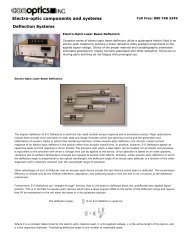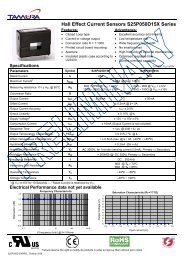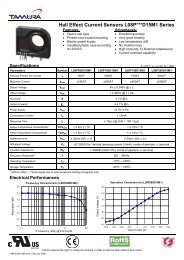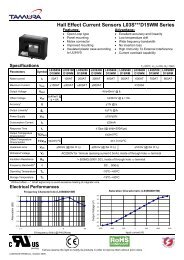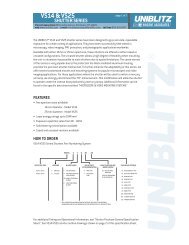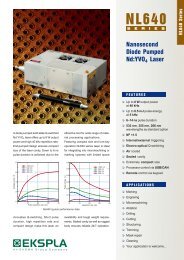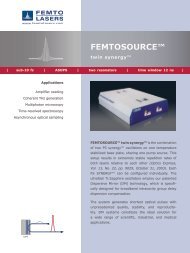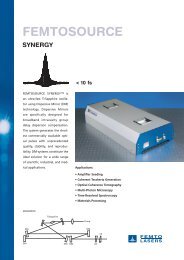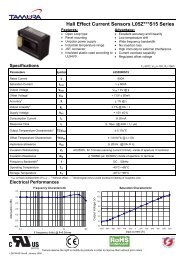Create successful ePaper yourself
Turn your PDF publications into a flip-book with our unique Google optimized e-Paper software.
OpticsEtalon BasicsEtalons forWavelength LockingEtalons are often used for stabilizinga laser’s frequency, or wavelength.In a typical “wavelengthlocker” that uses the side-fringe-lockingtechnique, a portion of the laser’soutput is transmitted through an etalonso that the center wavelength is halfwaydown the side of a transmission peak. Thetechnique takes advantage of the almostlinear slope on either side of the transmissionpeak where frequency variations will belinearly converted into amplitude variations.To eliminate spurious laser amplitude noise,a reference signal from the laser is removedfrom the transmitted etalon signal. The resultingclean signal can then be processedby a feedback control system to adjustthe frequency of the laser. For an exampleof our wavelength-locker designs,see pages 4–5.Etalons are also used as wavelengthreferences, interleavers,and periodic opticalfilters.A Fabry-Perot etalon, often simply called an etalon,is the most basic interferometer and consistsof two flat parallel mirrors separated by adistance L. In a solid etalon, which consists of asingle piece of transparent medium of index ofrefraction n, and thickness L, the incident beamundergoes multiple reflections between the twosurfaces of equal reflectivity R.The transmitted and reflectedsignal is the result ofmultiple-beam interference.The opticalphase acquired onone round trip throughthe etalon is given bywhere is the wavelength ofthe incident light. In a losslesssystem, transmission is 100% when, where m is an integer. Assuming a normalangle of incidence (θ=0˚), the peaks are separatedin frequency (remember that , wherec is the speed of light and is its frequency) bythe free spectral range (FSR) as expressed asThe actual transmitted intensity is expressed aswith .This function F is known as the coefficient of finesse.The transmission T is shown in the figurebelow and is known as the Airy function.As can be seen from the figure, etalons act aswavelength or frequency filters. An importantfigure of merit is the finesse because it defineshow narrow the filtering function is. The finesseis the ratio of the free spectralLrange to the full width at halfnmaximum (FWHM) of thetransmission peak andis directly related to thereflectivity of the surfaceR byThe figure below graphs thetransmission through etalonsof various reflectivities. Devices withhigher reflectivity, thus higher finesse, havenarrower FWHM.Note: the transmitted beam of a higher finesse deviceis the result of interference between beams thattravel many more times through the device. Thus,the physical limitation to the finesse is set by theoverall beam overlap of the etalon as limited by thedeviations of the surfaces from plane parallelism,coating losses, and beam characteristics (angle ofincidence, divergence, beam diameter, etc).Visit our web site atwww.precisionphotonics.comfor a PDF copy of this catalog andcopies of technical papers on:. Etalon Design Basics. Epoxy-Free Optical Bonding. High-Damage-ThresholdCoating TechnologiesNormalized Transmission10.9FSR0.80.70.60.5R=25%0.4FWHM0.3R=50%0.20.1R=90%0190.02 190.04 190.06 190.08 190.1 190.12Optical F r equency (THz )The Airy functions or transmitted intensities ofetalons of various reflectivities as a function offrequency. The higher the reflectivity, the higher thefinesse, and the narrower the FWHM.www.precisionphotonics.com 7



